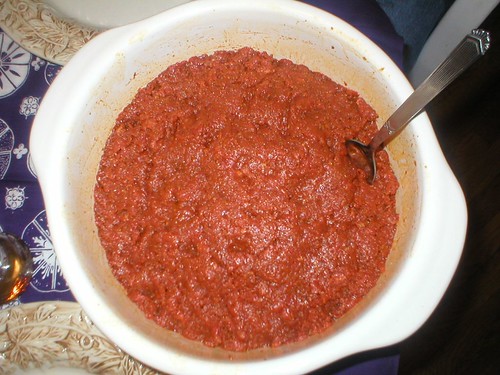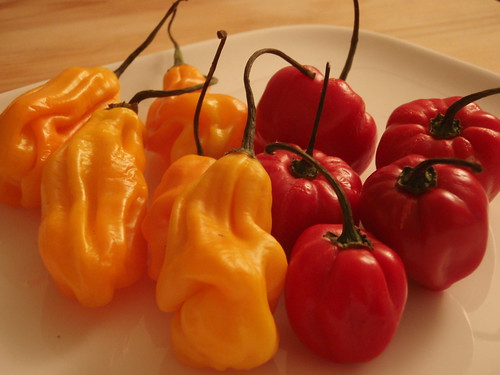Pimento, the spice of all spices
The star spice is the pimento, the dried unripe fruit of a plant version, which looks like peppercorn. The name always confuses me because there is also the succulent pimento bell pepper. In Portuguese, pimento is the bell pepper, pimenta is the spice. In English, pimento can refer to either. It's just like the term Indians.
We can call it by the other names, Jamaican peppers or allspice (I think this is the proper English name). But I like pimento better - it sounds more fun. Allspice got its name because it tastes like a combination of flavors like nutmeg, pepper and clove. It's used extensively in the Caribbean, and to some extent in Europe and Middle East, but almost none in Eastern Asia. It is the only spice that is exclusively grown in the Western Hemisphere.
It has a share in history too. Pirates of the Caribbean used it by for boucan, barbecuing anything from fish, pigs, feral cats to turtles. Presumably the strong smell of pimento masks the taste of bad meat used by the ungourmandy crew. So the story goes, the pirates who make boucan for provisions become known as buccaneers. Now, if there's one spice associated with buccaneering, it should be pimento, not something delicate like lavender.
Peppers, evil little peppersThe other trademark of the jerk sauce is the fiery
Scotch Bonnet peppers. These peppers are popular in Caribbean cuisine, like Jamaica or Trinidad and Tobago. I had to substitute that with
Madame Jeanette peppers which is Surinamese and has a more fruity flavor. They carry the same heat - an amazing 250,000 in the
Scoville scale which measures chili intensity. Usually peppers I use like
Thai pepper (
cabe rawit) is around 75,000 while cayenne pepper is 15,000. Not sure how to understand the scale in human sensory terms but it's an impressive number nonetheless.
In my quest for looking for Scotch Bonnet peppers, I found that the hottest pepper is the Indian
Naga Jolokia, with a whopping score of 850,000. So obsessed are these heat aficionados that they experiment crossbreeding to produce even hotter chili peppers (I can picture an Indian scientist, after creating the world's hottest pepper, screaming, "
It is being alive! It is being alive!")
Madame Jeanette, substitute for Scotch Bonnet peppers. Damn hot.
I hesitated to put six of these little devils for four servings, but I always try to follow the most authentic recipe available. It turned out hot, but not overwhelming hot. Then again I have been conditioned with chilies lately from
one of my latest experiment, the Bhutanese "chili curry"
Emma Datschi.

 Mise en place for jerk sauce, including pimento, pepper, nutmeg, ginger, lime, thyme, cinnamon, olive oil, orange juice, sugar, soy sauce (see complete recipe).
Mise en place for jerk sauce, including pimento, pepper, nutmeg, ginger, lime, thyme, cinnamon, olive oil, orange juice, sugar, soy sauce (see complete recipe).
The result following this recipe was a success, it was very tasty. The burnt sugars in the sauce made it rather black, but it is easy to scrape off to reveal juicy chicken underneath (remember to baste it now and then). The overall pimento taste was prominent in the palate, it's hard to individually distinguish the additional cinammon, cloves, and nutmeg added. Even then, next time I won't skimp on the spices. Usually you can look for a "simple" version and a "sophisticated" version of the recipe to get an idea which spices are essential. But from the numerous recipes I looked at, you may reduce the heat but never reduce the variety of spices. You need them all: pimento, peppers, nutmeg, ginger, lime, thyme, cinnamon, etc.
Jerk chicken, festival, rice and peas!
With the quantity of jerk chicken made for two meals, I paired them with two different side dishes. The first one is festival, a sweet flour-and-cornmeal dough, fried in oil. Again, the name festival is too good to pass up. I'm a sucker for some catchy food names. The festival is very sweet, it contains lots of sugar and vanilla.
The next day, we had rice and peas! The name may be unassuming, but the mix is really good. The rice and peas have contrasting textures and the coconut milk adds richness. It is also scented with Madame Jeanette peppers.

Jerk chicken with rice and peas (recipe) The two different pairings felt like two different concepts. The jerk chicken with sweet festival felt like a big between-meals snack, like hot dogs. The festival is great to be dipped in the jerk sauce. I'd say without sauce it may be too dry. Meanwhile, the jerk chicken with rice and peas feels more like a hearty dinner. I give a slight nod to the rice and peas. Both are great, but I felt the combination works just a little better there.
References:
1. Jerk chicken recipe from Jamaican Travel and Culture [
1A]; Festival [
1B]; Rice and peas [
1C].
2. Jerk chicken from Simply Recipes [
2]
3. Allspice from Encyclopedia of Spices [
3]
4. Allspice from Gernot Katzer's Spice Pages [
4]
5. Chilies from BBC.co.uk [
5]














